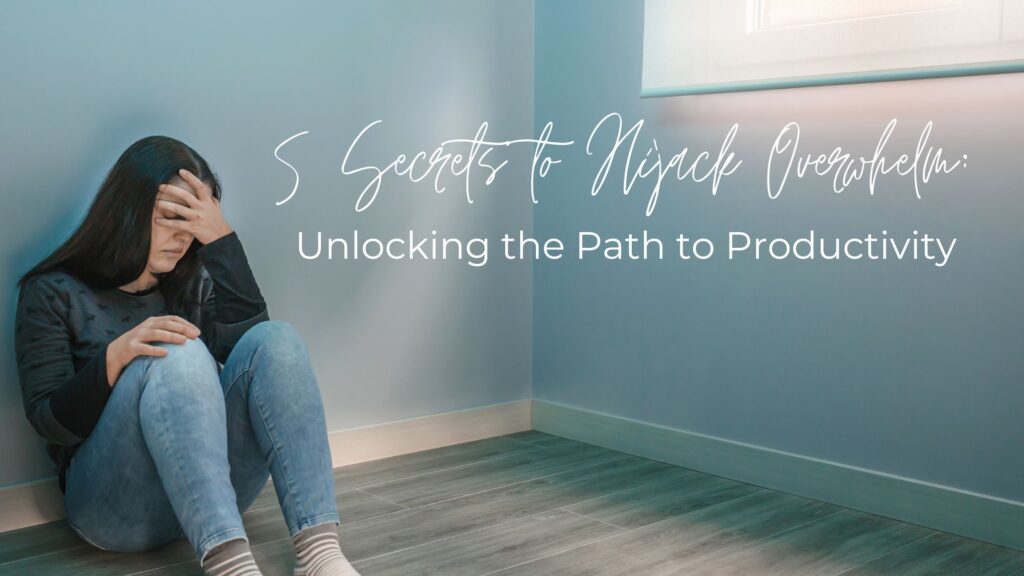Let’s set the stage: it’s 5 PM and your planner, replete with appointments, deadlines, and obligations, stares back at you. Your heart starts racing, your fingertips tingle, and your mind feels crippled by thoughts like I can’t handle this.
When overwhelm takes over, our nervous system becomes dysregulated, triggering a cascade of stress hormones that send signals to the most rational, healed part of our brain to “go offline.” In this state, our adult wants and needs—like being healthy, thriving professionally, and tapping into our highest selves—are instead eclipsed by unmet childhood needs, reopening old wounds. Our little selves take the wheel, and we engage in compensatory behaviors to meet these unhealed needs: over-functioning, procrastinating, perfectionism, and more.
Beating overwhelm begins with recognizing that it is a physical battle, not a mental one.
In this blog, we will unveil overwhelm’s hidden mind-body connection via 5 practical hacks to alleviate stress and optimize productivity from the place of your highest self.
Reframing overwhelm to fit into a physical—rather than mental—framework can empower us to diagnose the problem, self-soothe, and ultimately get ourselves “back online.” When we feel overwhelmed, our bodies succumb to fight or flight, pumping adrenaline and cortisol through our veins to activate the defense mechanisms that harness our capacity to survive—not thrive. In response, we forge a mental link between the physical sensation of overwhelm and those classic catastrophizing thoughts that paralyze productivity: I’m never going to get this done, I should have never said yes to this, why bother, etc. The trick here is to separate the somatic, felt sense of overwhelm from the negative thoughts associated with it. Once that happens, we can recognize that overwhelm is entirely self-imposed—a product of the meanings we construct from a physical sensation—and reclaim our power in shifting how we experience it.
Think of spaciousness as the antidote to the chaos in our minds, replacing catastrophizing with mindfulness, multi-tasking with meditative completion, and freneticism with calm. When we embrace the power of living in the present moment, we begin to slow down, chiseling out spaciousness within our lives. Spaciousness operates on the principle of radical faith—the idea that all time is precious and that everything always gets done when working from a place of spaciousness—because we attract more spaciousness! By recognizing the worth and significance of every moment, even the seemingly mundane ones, we tap into our innate genius, motivation, and intuition. Moments aren’t made for getting to the next moment.
Once you get your highest self back online, experiment with the Pomodoro Method for the task at hand. Using any old-fashioned timer or Pomodoro app, carve out a 20-25 minute stretch dedicated to “getting started” on the project. You should find that once you get going, free from cortisol-fueled stress and immersed in spaciousness, you will make significant headway on the task. And if not, the good news is that you only have to expend 25 minutes working on it. This time-management method hijacks overwhelm by breaking the task into more digestible segments, enhancing focus and restoring radical faith in your ability to get things done. Strategize and time-block your Pomodoro sessions for when you have the most energy and tackle the most overwhelming projects!
The Bottom Line
Investing in a lavish planner or vowing to increase your bandwidth are not effective or realistic strategies to override overwhelm; the problem is physical, not mental. When you feel your feelings—without attaching destructive thoughts to them—you prevent overwhelm from overshadowing who you really are: a capable, ambitious, and remarkable human.
For more strategies to optimize everything in life from the place of your highest self, DM @marnibattista on Instagram and email VIP@datingwithdignity.com if you want our cheat sheet on overcoming imposter syndrome!




